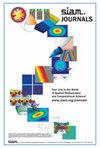On Assignment Problems Related to Gromov–Wasserstein Distances on the Real Line
IF 2.3
3区 数学
Q3 COMPUTER SCIENCE, ARTIFICIAL INTELLIGENCE
引用次数: 2
Abstract
Let and , , be real numbers. We show by an example that the assignment problem \begin{align*} \max_{\sigma \in S_n} F_\sigma (x,y) := \frac 12 \sum_{i,k=1}^n |x_i- x_k|^\alpha \, |y_{\sigma (i)}- y_{\sigma (k)}|^\alpha, \quad \alpha \gt 0, \end{align*} is in general neither solved by the identical permutation nor the anti-identical permutation if . Indeed the above maximum can be, depending on the number of points, arbitrarily far away from and . The motivation to deal with such assignment problems came from their relation to Gromov–Wasserstein distances, which have recently received a lot of attention in imaging and shape analysis.实线上与Gromov-Wasserstein距离有关的分配问题
设和为实数。我们通过一个例子证明了分配问题\begin{align*} \max_{\sigma \in S_n} F_\sigma (x,y) := \frac 12 \sum_{i,k=1}^n |x_i- x_k|^\alpha \, |y_{\sigma (i)}- y_{\sigma (k)}|^\alpha, \quad \alpha \gt 0, \end{align*}一般既不能用同置换解决,也不能用反同置换解决。实际上,根据点的数量,上述最大值可以是任意距离和的值。处理这种赋值问题的动机来自于它们与Gromov-Wasserstein距离的关系,后者最近在成像和形状分析中受到了很多关注。
本文章由计算机程序翻译,如有差异,请以英文原文为准。
求助全文
约1分钟内获得全文
求助全文
来源期刊

SIAM Journal on Imaging Sciences
COMPUTER SCIENCE, ARTIFICIAL INTELLIGENCE-COMPUTER SCIENCE, SOFTWARE ENGINEERING
CiteScore
3.80
自引率
4.80%
发文量
58
审稿时长
>12 weeks
期刊介绍:
SIAM Journal on Imaging Sciences (SIIMS) covers all areas of imaging sciences, broadly interpreted. It includes image formation, image processing, image analysis, image interpretation and understanding, imaging-related machine learning, and inverse problems in imaging; leading to applications to diverse areas in science, medicine, engineering, and other fields. The journal’s scope is meant to be broad enough to include areas now organized under the terms image processing, image analysis, computer graphics, computer vision, visual machine learning, and visualization. Formal approaches, at the level of mathematics and/or computations, as well as state-of-the-art practical results, are expected from manuscripts published in SIIMS. SIIMS is mathematically and computationally based, and offers a unique forum to highlight the commonality of methodology, models, and algorithms among diverse application areas of imaging sciences. SIIMS provides a broad authoritative source for fundamental results in imaging sciences, with a unique combination of mathematics and applications.
SIIMS covers a broad range of areas, including but not limited to image formation, image processing, image analysis, computer graphics, computer vision, visualization, image understanding, pattern analysis, machine intelligence, remote sensing, geoscience, signal processing, medical and biomedical imaging, and seismic imaging. The fundamental mathematical theories addressing imaging problems covered by SIIMS include, but are not limited to, harmonic analysis, partial differential equations, differential geometry, numerical analysis, information theory, learning, optimization, statistics, and probability. Research papers that innovate both in the fundamentals and in the applications are especially welcome. SIIMS focuses on conceptually new ideas, methods, and fundamentals as applied to all aspects of imaging sciences.
 求助内容:
求助内容: 应助结果提醒方式:
应助结果提醒方式:


